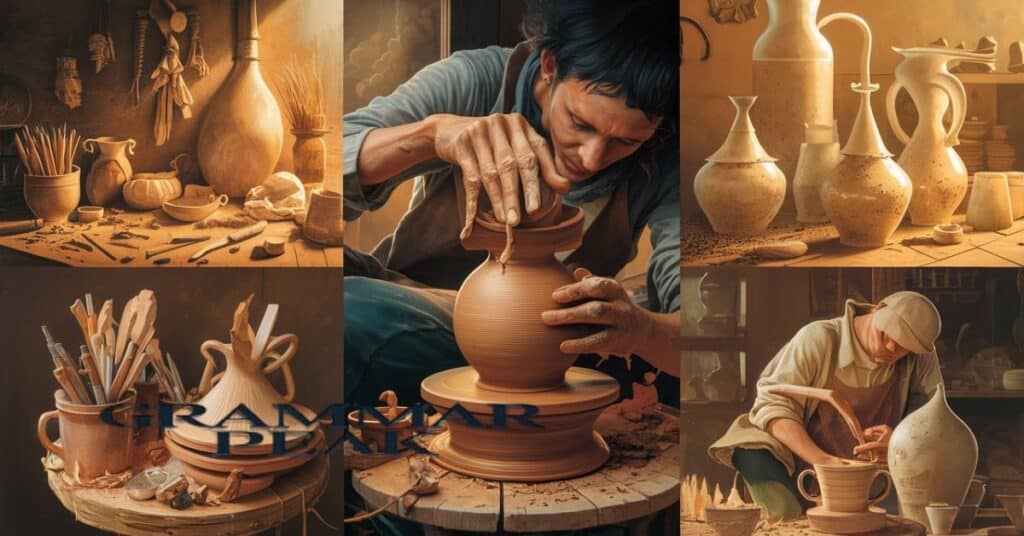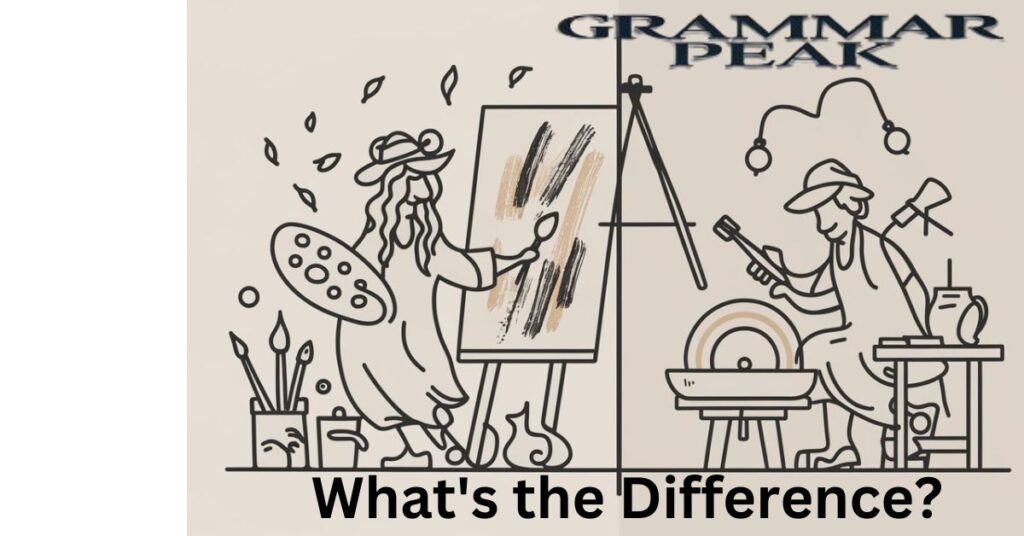Understanding the nuances between an artist and an artisan can be a fascinating journey into creativity, craftsmanship, and expression. Both artists and artisans bring unique perspectives and skills to their work, however, the distinctions between them often blur.
This article will delve into the differences, exploring the roles of artists and artisans, their focuses, processes, and materials, the origins of the terms, and real-life examples of both.
Who is an Artist?
An artist is often seen as a person who creates art as a form of self-expression. This can encompass various mediums and styles, from painting and sculpture to digital art and performance.
Artists evoke emotions, challenge societal norms, and emotionally and intellectually engage with their audience. Their work often leans more towards the aesthetic, emotional, and conceptual, with an emphasis on originality and a deep desire to express something about the world or themselves.
You will like Artist vs Artisan: What’s the Difference?
Who is an Artisan?

On the other hand, an artisan is generally considered a skilled craftsperson who creates functional items with a high level of craftsmanship. This can involve traditional skills like woodworking, pottery techniques, metal forging, textile weaving, glassblowing, or jewelry making.
Artisans create practical items that often have an aesthetic design, but their primary focus is on the functionality and durability of their creations, using traditional methods and hands-on techniques.
Artist vs Artisan: The Differences
Focus
When comparing the differences between artist and artisan, one key distinction is that focus plays a significant role. Furthermore, this emphasis on focus can lead to notable variations in their approaches. An artist’s work is often more focused on self-expression, aiming to evoke emotions and provoke thought.
Their work lies in the realm of fine arts; therefore, they use their unique style to create pieces that are meant to be appreciated for their beauty and emotional power. Additionally, this focus on emotional resonance enhances the viewer’s experience. Conversely, an artisan’s focus is primarily on creating functional objects; moreover, this often involves a high level of craftsmanship. In addition, the attention to detail in their work enhances the overall quality of the items produced.
Process
The process followed by artists and artisans, in contrast, also differs significantly. Moreover, artists often embrace a more fluid and experimental approach, while artisans typically adhere to established techniques and methods. In contrast, artists often engage in a more exploratory approach; similarly, artisans focus on precision and craftsmanship. Additionally, this distinction highlights the different philosophies that guide their creative processes. Artists often work from a place of imagination and skill, allowing their creative soul to guide their work. The artistic process is often more fluid, with the final product being a unique piece of art.
Artisans, on the other hand, usually follow a more structured process; in addition, they utilize tools and techniques that have been passed down through generations. Moreover, this commitment to tradition not only preserves their craft but also enhances the quality of their creations. As a result, this adherence to tradition enhances the quality and authenticity of their work. Furthermore, it fosters a deeper connection to cultural heritage, which in turn enriches the overall artistic expression. Their work involves a high level of practical craftsmanship, with each piece meticulously crafted to ensure its functionality and durability.
Uniqueness
As a result, this adherence to tradition enhances the quality and authenticity of their work. Furthermore, it fosters a deeper connection to cultural heritage, which in turn enriches the overall artistic expression. Artists often strive for originality in their work, challenging societal norms, and pushing boundaries with their creative and conceptual art.
Art installations, exhibitions, and pieces are often one-of-a-kind, reflecting the artist’s vision and style.Regarding uniqueness, both artists and artisans have their distinct contributions. In addition, artists often push boundaries and explore new ideas, while artisans focus on creating functional and beautiful objects. Thus, their unique contributions enrich our cultural landscape in complementary ways.
Materials
Artisans, although they create unique pieces, often produce items that are similar to each other. In fact, this similarity can be attributed to traditional techniques and styles that are passed down through generations. Consequently, their work reflects both individuality and a shared heritage. Artists may use a range of conventional and unconventional materials, depending on their artistic vision. These can range from paints and canvas to digital tools, or even recycled materials.
Artisans, by contrast, typically use more traditional materials like wood, clay, metal, or textiles. The materials selected are often chosen for their durability and functionality, integral to the production of their high-quality pieces.
Here’s a table that illustrates the differences between an artist and an artisan:
| Aspect | Artist | Artisan |
| Purpose | Artists primarily create to express personal or societal feelings, ideas, and narratives through their work. | Artisans craft mainly for functionality, producing items that serve a practical purpose. |
| Value | The value of an artist’s work lies in its originality, creativity, and emotional resonance. | The value of an artisan’s work is in its craftsmanship, durability, and utility. |
| Techniques | Artists may use a wide array of techniques and mediums, often pushing the boundaries of traditional methods. | Artisans generally adhere to time-tested techniques that ensure the functionality and quality of their products. |
| Examples | Painters, sculptors, performance artists, digital artists. | Potters, blacksmiths, leatherworkers, bakers. |
| Exhibition | Artists typically showcase their work in galleries, museums, or public installations. | Artisans often sell their products in markets, shops, or online platforms. |
You Might Be Artist vs Artisan: What’s the Difference?
Origins of the Words “Artist” and “Artisan”
Origins of the Word “Artist”
The word “artist” has an intriguing historical journey. Its roots can be traced back to the Latin term “artista”, a word reserved for individuals possessing notable skills in any craft or field of knowledge.
This broad classification encompasses, for example, a spectrum of professions, from sculptors to scholars, who are all linked by their mastery and dedication to their respective crafts. Additionally, this connection highlights the diverse yet unified nature of creative and intellectual pursuits within the arts. Nevertheless, as societies evolved and the fine arts began to occupy a distinct cultural space, the term “artist” transformed.
Consequently, this shift reflected broader changes in societal values and perceptions of creativity. Thus, the definition of an artist became more nuanced and inclusive over time. It started to become closely associated with individuals engaged in the fine arts, such as painting, sculpture, and music. Furthermore, this association highlighted the growing recognition of these disciplines as essential forms of cultural expression. As a result, the perception of what constitutes an artist began to shift significantly.
Origins of the Word “Artisan”
The term “artisan” carries a rich heritage that speaks volumes about its essence. It is derived from the Old French word “artisanal”, used to denote someone proficient in a craft. The term was a reflection of societal structures where craftsmanship held significant value, highlighting the importance of making functional objects that served daily needs.
As societies modernized, the term “artisan” maintained its core meaning; however, it gained additional layers of connotation. While it continued to describe individuals who create functional objects, moreover, there was now an emphasis on the mastery of traditional craftsmanship. Thus, artisans became recognized not only for their utility but also for their skill and artistry.
“Artist” and “Artisan” Examples
Examples of Artists
1. Performance Artist: Combines various artistic disciplines in live presentations.
- Creates dynamic performances that could involve elements of theatre, dance, music, or visual art.
- Performs in a wide variety of venues, from traditional theaters to outdoor public spaces.
2. Digital Artist: Uses computer technology as a tool or a medium to create art.
- Develops graphics, animations, or digital paintings that often push the boundaries of traditional artistic expression.
- Showcases their work on online platforms or in digital art exhibitions.
3. Illustrator: Draws or paints images for use in various media.
- Creates detailed visuals for books, magazines, or commercial products.
- Their work can be seen in print, digital media, or in gallery exhibitions.
4. Photorealist Painter: Creates paintings that closely resemble high-resolution photography.
- Produces detailed and hyper-realistic paintings that can often be mistaken for photographs.
- Exhibits their work in art galleries or museums.
5. Conceptual Artist: Primarily, this type of artist focuses on the ideas and concepts behind the artwork rather than the finished art product. In addition, their work often challenges traditional notions of art by prioritizing the underlying message over aesthetic qualities. Consequently, the value of the artwork lies in its conceptual depth and intellectual engagement.
- Creates works that provoke thought, challenge societal norms, or comment on political or cultural phenomena.
- Presents their work in art galleries, museums, or public installations.
6. Cartoonist: Draws humorous or satirical images, often for publication in newspapers or magazines.
- Creates single-panel cartoons or full-length comic strips, often with recurring characters.
- Shares their work in print, online platforms, or animated adaptations.
7. Graffiti Artist: Uses spray paint or other mediums to create art on walls and other surfaces in public spaces.
- Crafts murals or tagged artworks, often with social or political messages.
- Their work can be seen on city streets, buildings, or transportation systems.
8. Collage Artist: Creates artwork from an assemblage of different forms, often from different media.
- Produces pieces that blend cut-out or torn images, textures, and occasionally text or objects. Additionally, this approach allows for a dynamic interplay of visual elements. Moreover, it creates a layered effect that enhances the overall composition. Consequently, the resulting artwork often invites deeper exploration and interpretation.
- Exhibits their work in art galleries, online platforms, or art festivals.
9. Assemblage Artist: Makes three-dimensional compositions from putting together found objects.
- Constructs pieces from a variety of materials, often with an emphasis on texture and spatial relationships.
- Showcases their work in art galleries, museums, or sculpture parks.
10. Video Artist: Uses the medium of video to create art installations or performances.
- Creates video art pieces that may involve elements of storytelling, abstraction, or real-time performance footage.
- Presents their work in art galleries, museums, or film festivals.
Examples of Artisans
1. Blacksmith: Shapes iron or steel into functional items or decorative pieces using tools and heat.
- Crafts items like gates, railings, tools, or sculptural pieces.
- Employs traditional forging methods that require a forge, anvil, and hammers.
2. Leatherworker: Crafts functional and aesthetic items from leather.
- Creates products like belts, wallets, bags, or custom leather goods.
- Utilizes various leatherworking techniques, including cutting, carving, and stitching. In addition, these methods allow for a diverse range of creative possibilities. Furthermore, each technique contributes uniquely to the overall design and functionality of the leather piece. As a result, artisans can achieve intricate details and durable constructions in their work.
3. Textile Weaver: Creates fabric or textile art through the interlacing of threads.
- Weaves items like rugs, tapestries, or cloth for clothing.
- Operates on looms, which may be hand-operated or mechanized.
4. Baker: Prepares a wide variety of baked goods using traditional or modern baking techniques.
- Produces breads, pastries, cakes, and other baked treats.
- Uses ovens and a variety of baking tools for the creation of their goods.
5. Jeweler: Crafts decorative items, primarily accessories, from precious metals and gemstones.
- Designs and creates rings, necklaces, earrings, and bracelets.
- Uses techniques like casting, soldering, and stone setting.
6. Wood Carver: Creates decorative and functional items by carving or sculpting wood.
- Produces items like furniture, sculptures, or architectural details.
- Uses tools like chisels, gouges, and knives for detailed hand carving.
7. Glass Artist: Manipulates glass to create a range of functional and decorative items.
- Crafts pieces like vases, bowls, sculptures, or stained glass panels.
- Uses techniques such as blowing, casting, or fusing glass. Additionally, these methods each offer unique advantages in the creation of glass art. For instance, blowing allows for the formation of intricate shapes, while casting enables the production of detailed designs in molds. Moreover, fusing combines different glass pieces to create stunning visual effects. Consequently, artists can choose the technique that best suits their creative vision.
8. Cheesemaker: Crafts various types of cheese using traditional or modern methods.
- Produces a variety of cheese types, from cheddar to brie.
- Employs a process that includes curdling, draining, salting, and aging.
9. Candlemaker: Creates candles of varying sizes, shapes, and scents.
- Produces items like pillar candles, votives, or scented candles.
- Uses processes such as pouring, dipping, or molding wax. In addition, each of these methods plays a crucial role in the creation of wax-based art. For example, pouring allows for the formation of smooth, even layers, whereas dipping can create textured surfaces. Moreover, molding wax enables artists to achieve intricate shapes and designs. As a result, these techniques collectively enhance the versatility and creativity of wax art.
10. Bookbinder: Crafts or repairs books by hand, attaching the pages to the cover.
- Produces items like journals, notebooks, or restored books.
- Uses traditional bookbinding techniques that include sewing, gluing, and cutting.
FAQ” S
What is the difference between an artist and an artisan?
An artist creates work primarily for its aesthetic value and emotional resonance, while an artisan focuses on creating functional items with a high degree of craftsmanship.
Can someone be both an artist and an artisan?
Yes, many creatives blur the lines between artist and artisan, using their skills to create works that are both functional and artistically expressive.
What are some examples of traditional artisans?
Traditional artisans include potters, blacksmiths, weavers, and leatherworkers, who often use time-honored techniques to create their products.
What are some examples of modern artists?
Modern artists can include digital artists, conceptual artists, and performance artists, who often use contemporary tools and ideas in their work.
Where can I see the work of artists and artisans?
The work of artists and artisans can be seen in various settings, from art galleries and museums to craft fairs and online platforms.
Conclusion
Artists and artisans, from sculptors and digital artists to blacksmiths and leatherworkers, have enriched our world with their unique skills and creativity. Their work, whether pushing the boundaries of visual art, crafting intricate designs or expressing imaginative concepts, highlights the importance of innovative artistry and traditional craftsmanship. Their contributions enhance aesthetic appeal and reflect cultural narratives and societal dialogues, making them indispensable to our cultural, societal, and creative landscapes.

Mason Blake is an experienced blogger with a passion for language and communication. With years of expertise in crafting informative and engaging content, Mason shares valuable insights on grammar and writing. His clear, concise, and reader-friendly approach has earned him a loyal following, helping readers sharpen their language skills and master the art of effective communication.








I don’t think the title of your article matches the content lol. Just kidding, mainly because I had some doubts after reading the article.
Thanks for sharing. I read many of your blog posts, cool, your blog is very good. https://www.binance.com/en-IN/register?ref=UM6SMJM3
Can you be more specific about the content of your article? After reading it, I still have some doubts. Hope you can help me.
Thank you for your sharing. I am worried that I lack creative ideas. It is your article that makes me full of hope. Thank you. But, I have a question, can you help me?